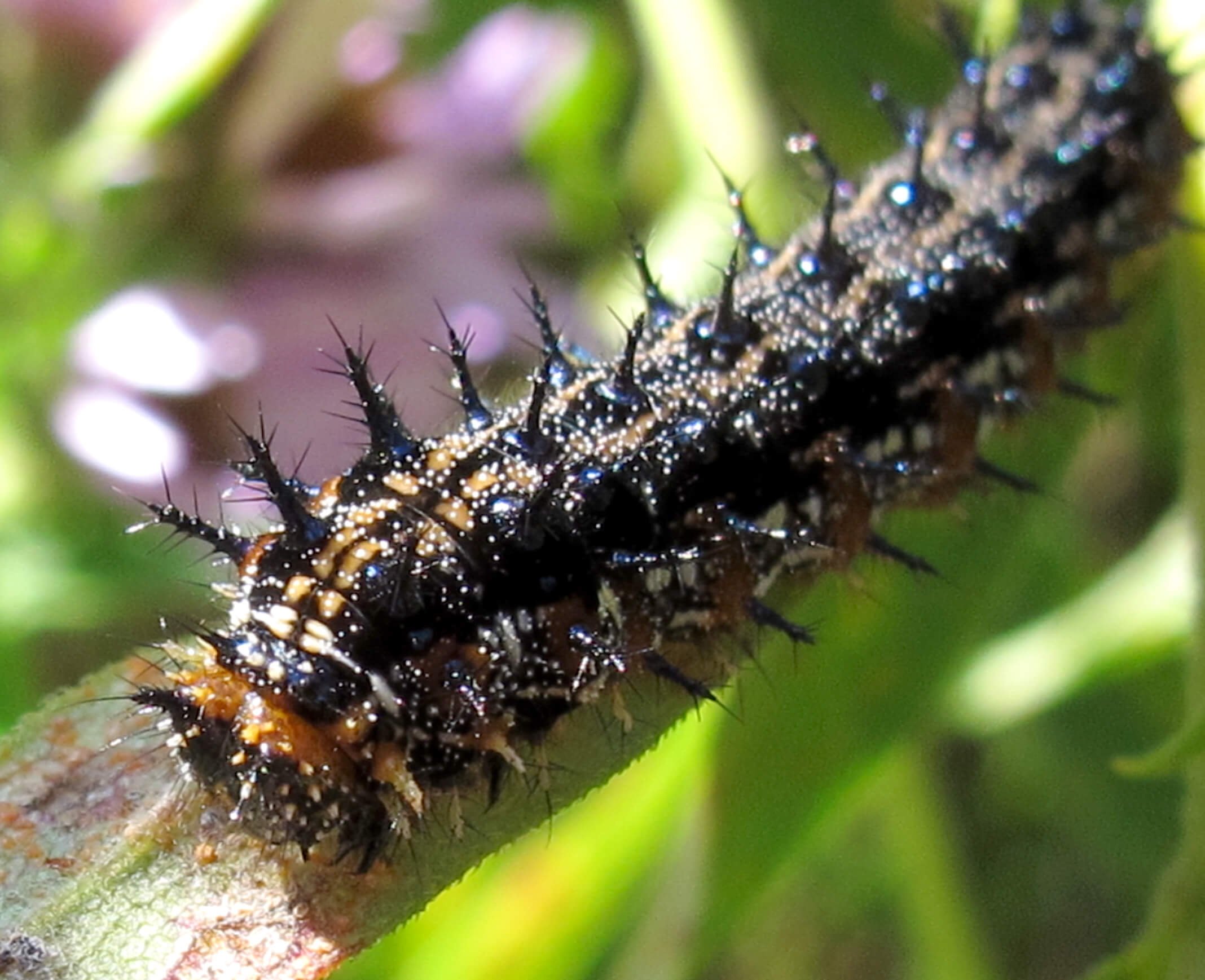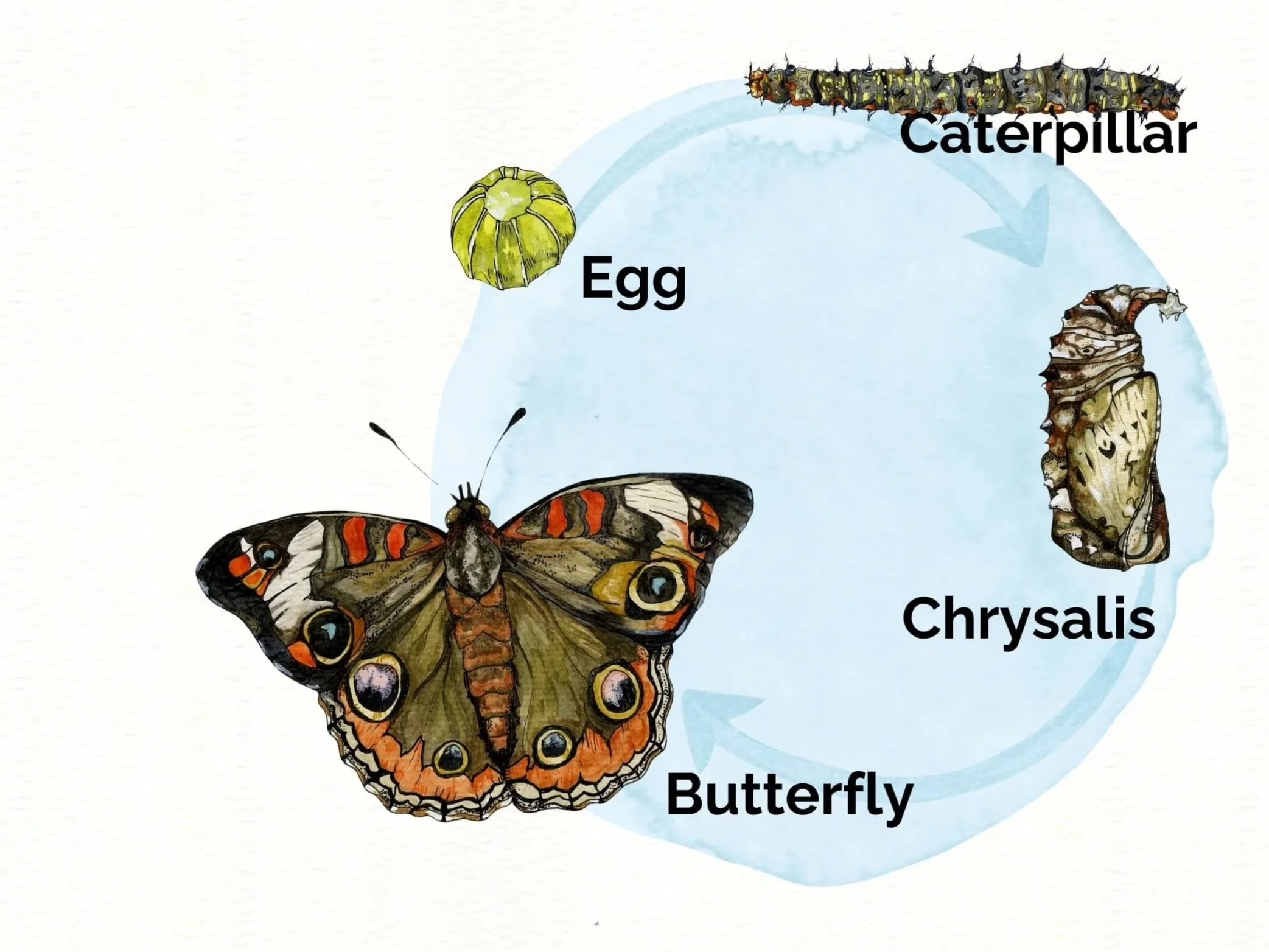
Common Buckeye
Junonia coenia
Photo: Pete Dixon
UNC Asheville, Glenn’s Creek Greenway
Keep your eye out for eyespots as you travel down WT Weaver Boulevard. The Common Buckeye is located near its intersection with Barnard Avenue. Parking for the Greenway is available nearby. Thanks to Dr. Matt Bertone of NCSU for providing the photo for the giant wings.
Sponsored in Loving Memory Of
Sarah Frances Brodie Lesesne
by her daughter Liz Lesesne
Robert J. Parr
by his daughter Suzanne Wodek
With Support From

Meet the Butterfly
The Common Buckeye is named for its striking eyespots, which resemble a male deer's eyes.
Eyespots may deter predators by making a butterfly look like a larger animal. A hungry bird may be startled or confused by the conspicuous markings.
Common Buckeyes are brown with two orange bars and two eyespots on top of each forewing. A creamy white band often meets the larger eyespot.
They have two more eyespots and an orange band on each hindwing.
Photo: Rhododendrites, CC BY-SA 4.0, via Wikimedia Commons
Seasonal Variations in Wing Color
Buckeyes that emerge in summer have brownish tan undersides like the butterfly in the background. The inset image is an autumn-emergent buckeye with deep rosy brown undersides.
Photos: David Kastner (inset) and Pete Dixon (background)

Buckeyes belong to the “brushfooted” butterfly family (Nymphalidae), along with the Gulf Fritillary and Monarch.
Their front two legs are small and fuzzy. You can barely see one held close to the body below this Buckeye’s eye.
The curly “tongue” (proboscis) emerges from between the butterfly’s hairy labial palps and acts as a straw when a butterfly sips nectar.
As they sip nectar, adult butterflies carry pollen from flower to flower on their wings and body.
Photo: Sam Fraser-Smith, CC BY 2.0 , via Wikimedia Commons
A Hard Act to Follow
Buckeyes have a distinctive, erratic flight pattern, alternating between short, rapid flights and gliding.
This makes it hard for predators to predict their next move!
Photo: Thomas Elliott/Pexels
Common Buckeyes have an average wingspan of 2 inches, the size of the short edge of a business card.
Photo: Pete Weiler
Distribution
In Western North Carolina, Buckeyes produce multiple generations annually, emerging from May to October.
They migrate south in the fall to overwinter and reproduce. Their offspring fly north to breed the following year.
Life Cycle
With a brief adult lifespan of 6-20 days, male Buckeyes are territorial and feisty! They guard areas of bare ground or low nectar plants, waiting to mate with females.
In the photo below, the female (on right) is larger than the male.
Illustration: Lauren Gingery. Photo: Pete Dixon.
Caterpillar Host Plants
Common Buckeyes lay a single green egg on the upper side of the leaves of many local native species—but not the Buckeye tree (as we originally assumed)!
They have many options. Their native perennial hosts include Woodland Stonecrop, Appalachian and Foxglove Beardtongue, White and Blue Vervain, and Wild Petunia. Their native annual hosts include Canada Toadflax, American Speedwell, and False Foxglove. They will also use some non-native cousins of many of these plants, particularly in the plantain family.
-

Woodland stonecrop
Sedum ternatum
Succulent ground cover that hosts Buckeye and Variegated Fritillary caterpillars. It is tolerant of shade, rabbits, and deer.
-

Appalachian Beardtongue
Penstemon canescens
The leaves of Penstemon provide food for Buckeye caterpillars, but the nectar of the flowers is out of reach for their butterflies’ tongues.
Adventurous Eaters
Most butterflies and moths are highly selective about caterpillar host plants, usually relying on a few specific natives. But Buckeyes aren’t terribly picky.
Whether native or nonnative, the plantain family is a favorite of Buckeyes, including both gorgeous snapdragons and the European plantain that lawn enthusiasts hate and herbalists love.
Photos: Stonecrop by Cbaile19, CC0, and beardtongue by homeredwardprice, CC BY 2.0, via Wikimedia Commons.

Buckeye caterpillar spines look scary but they’re harmless.
Thanks to its diet of plants loaded with toxic iridoid glycoside chemicals, the caterpillar tastes disgusting to predators.
Photo: Jacy Lucier, CC BY-SA 4.0, Wikimedia Commons
When a caterpillar transforms into a butterfly, its three pairs of true legs develop into adult legs, while its prolegs completely disappear.
Photo: Judy Gallagher
Have You Seen a Buckeye Chrysalis?
The dark mass above is the last skin shed by the caterpillar before transforming.
A wing and eyespot are visible on both of these chrysalises.
Buckeyes expel the toxins they consumed as caterpillars when they emerge from the chrysalis. That may be a way of protecting themselves while their wings are “inflating” and drying, the time when they are most vulnerable to being eaten.
Chrysalis photos: David Kastner
Color Your Own Buckeye Butterfly
Download a free coloring page by Nina Veteto below.
How You Can Help
Common buckeyes are not threatened, but you can still help reverse decline by taking action:
Add caterpillar host plants like Woodland Stonecrop, Appalachian and Foxglove Beardtongue, White and Blue Vervain, and Wild Petunia. Snapdragons are also a great food for Buckeyes!
Include flowers in your garden for nectaring adults.
Remove exotic invasive plants that displace native species.
Avoid pesticide use.
Leave the leaves and stems for overwintering chrysalises.
Learn more about Pollinator Gardening Principles and create a certified pollinator habitat in your yard.
Photo: Common buckeye on rattlesnake master, Dr. Thomas G. Barnes, USFWS, Public domain, via Wikimedia Commons.
Photo: Common buckeye, partial rosa form, David Kastner
Thank You
Many people and organizations made this Butterfly Trail possible. See the full list.
For the Common Buckeye Butterfly, we’d like to give a special thanks to:
University of North Carolina at Asheville for hosting the station!
UNCA NEMA lab, and especially Lauren Gingery, for their illustration support
Dr. Matt Bertone, Department of Entomology and Plant Pathology, NC State University for taking photos of their butterfly specimens for the freestanding wings
Amy Landers at Landers Creative for webpage design
Jill Jacobs at Spriggly’s Beescaping for interpretive sign design
Nina Veteto at Blue Ridge Botanic for the coloring page
And these incredible photographers:
David Kastner
Pete Dixon
Judy Gallagher






















